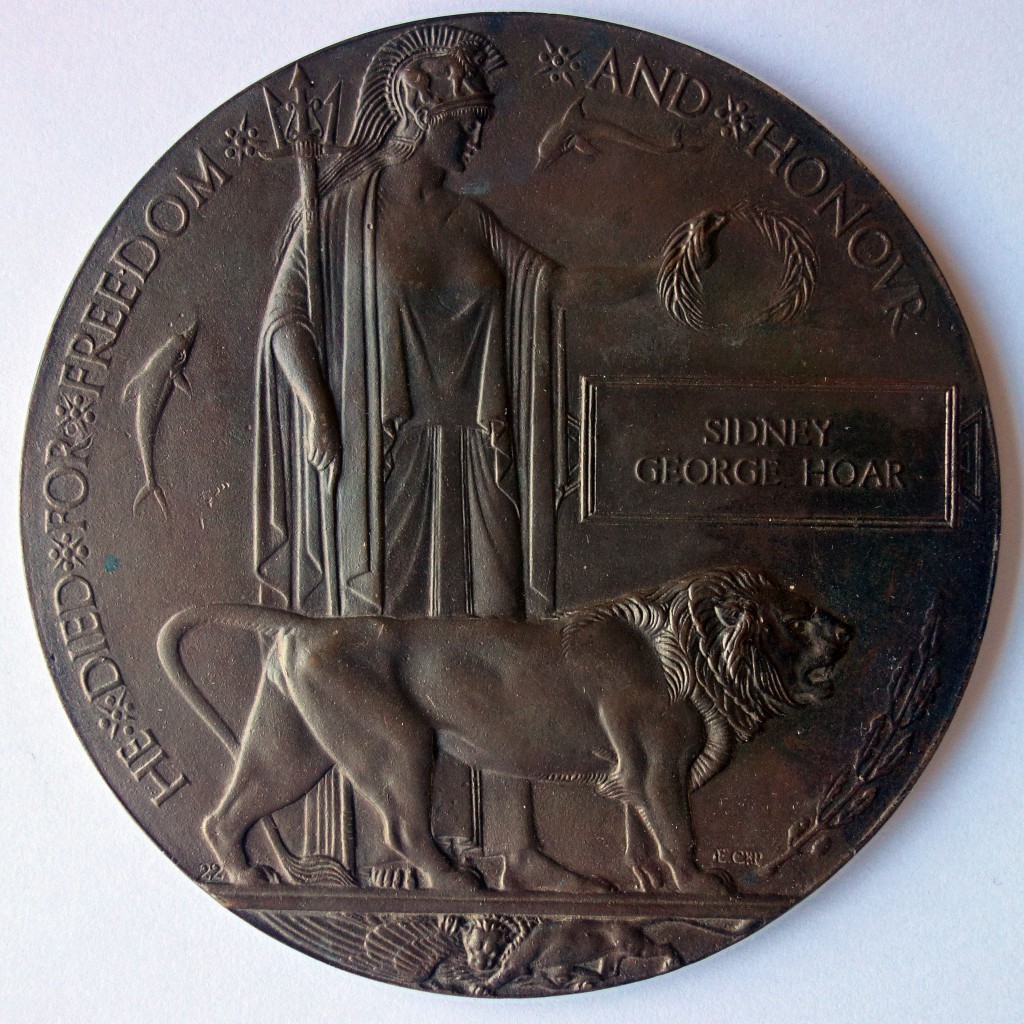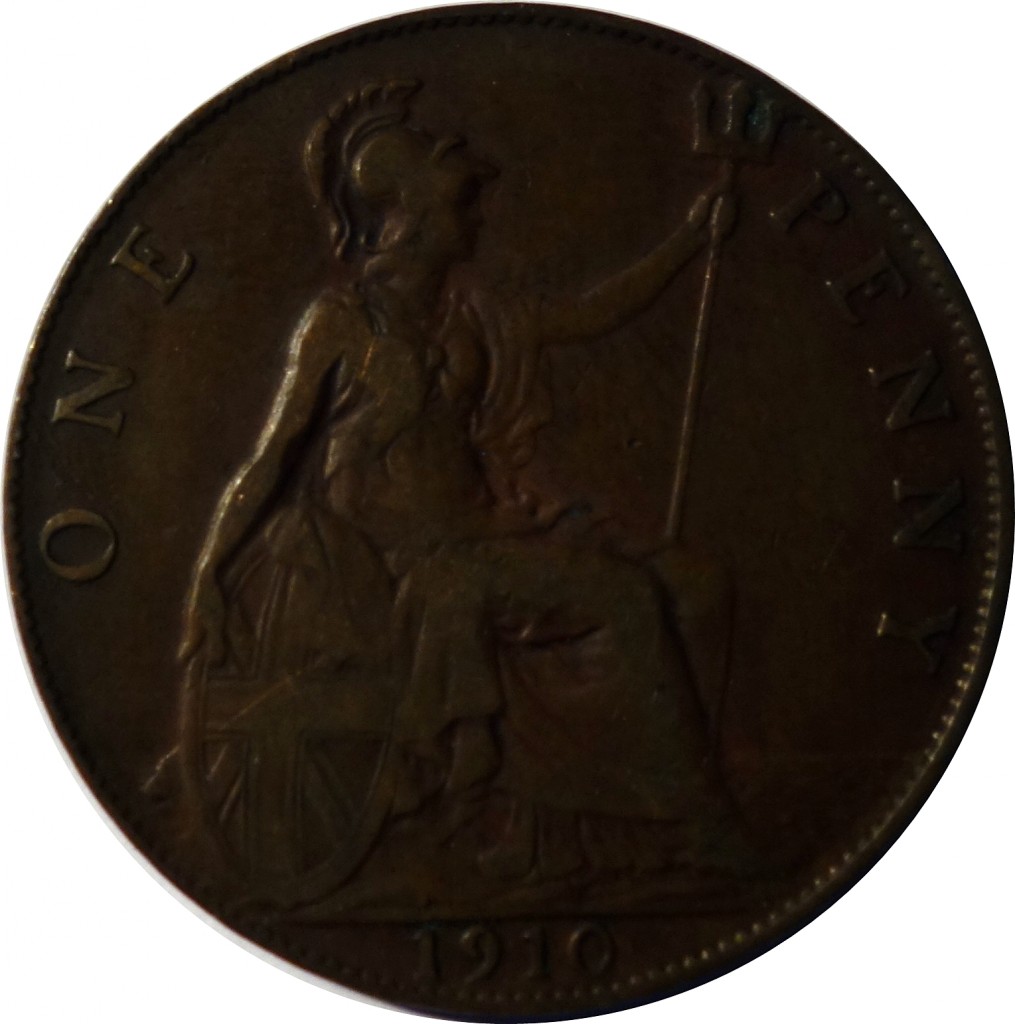This article is about the First World War memorial plaque and will explain what a memorial plaque is, the available records, the symbolism behind the design and how it was made. This page is one of a series of guides I have created to help you research soldiers who served in the British Army during the First World War:
What is a WW1 Memorial Plaque?
In 1916, the British Government decided that steps should be taken to create a memorial for the next-of-kin of service personnel who had died during the war. In the summer of 1917, it was announced that a government committee had decided that the memorial would take the form of a bronze plaque. In addition to the memorial plaque, the next-of-kin would also receive a memorial scroll. Each plaque was individually cast with the name of the soldier appearing in a rectangular box and sent out to the next-of-kin after the war.
The memorial plaque to Sidney George Hoar can be seen below and this would have been sent to his next-of-kin shortly after the war. Hoar was killed when a plane dropped a bomb on the lorry he was driving in Salonika. To find out more about this soldier I searched his name on the Commonwealth War Graves Commission database. As there was only one Sidney George Hoar who died during the First World War I was able to quickly find him.
First World War Memorial Plaque Records
Unfortunately, the original documents recording where the memorial plaques were sent and who to have not survived. If you have a memorial plaque and wish to find out more about the soldier I’d recommend starting with the resources below:
- Commonwealth War Graves Commission Database (free to view and search online)
- Soldiers who Died in the Great War ( available on FindmyPast and Ancestry)
- Army Register of Soldiers’ Effects 1901-1929 (available on Ancestry only)
Clicking on the banner below will take you to Findmypast which has a free trial period where you can search Soldiers who Died in the Great War and view a wide variety of other First World War records.
If you have a memorial plaque to a family member and no medals or other documentation and they have a common surname, Clark, Jones, Smith etc. then there’s likely to be multiple candidates. However, the resources above will hopefully provide enough biographical information to find the correct soldier. Be aware that though the Commonwealth War Graves Commission had a commemoration cut-off date of 31 August 1921 for soldiers who died from the effects of the war, the memorial plaque continued to be issued after this date. If you have a plaque and can find no name on the CWGC website you should search the death registration indexes to see if you can find a likely match in the 1920s: How to Order a Death Certificate.
The Competition to Design the WW1 Memorial Plaque
A competition to design the memorial plaque was announced in The Times on 13 August 1917.
WAR MEMORIAL FOR NEXT-OF-KIN
GOVERNMENT PRIZES FOR THE BEST DESIGN
Applicants were instructed that their designs had to be ‘as near as possible 18 square inches. It may be a circles of 4 1/2 in. diameter, or a square of 4 1/2 in., or a rectangle of 5 in. by 3.5 in. …’. The only other stipulations were that the design should include the inscription HE DIED FOR FREEDOM AND HONOUR, and ‘competitors are reminded that the design should be essentially simple and easily intelligible’. The competition was only open to British born subjects and the closing date for entries was 1 November, subsequently pushed back to 31 December 1917.
To avoid any accusations of bias, each design submitted to the National Gallery was given a pseudonym, with the artist’s name in a sealed envelope. There were over 800 entries and in January 1918 Pyramus by Edward Carter Preston was picked as the winner. Edward Preston’s initials can be found to the right of the lion’s paw. One of the runners-up was William McMillan who would go on to design the British War Medal and Victory Medal.
Design and Symbolism of the Memorial Plaque
The memorial plaque is 120 mm (4.7″) in diameter and cast from solid bronze. Just like the British War Medal and Victory Medal, the plaques’ design is deeply symbolic. The central figure of Britannia symbolises British imperial power and unity. In her right hand, she grasps Poseidon’s trident as a symbol of British naval dominance, while holding out a laurel wreath symbolising victory. The laurel wreath is held directly above a box containing the name of the deceased. She wears classical robes, and at her feet is a lion, found on the Royal Arms of England and representing both Britain and the Empire. The lion stands staring ahead, its mouth open, while beneath its feet a smaller lion bites into an eagle. An eagle appeared on the coat of arms of the German Empire, and the same motif can be found on the British War Medal where a horse tramples a shield containing the bird. Around Britannia are two dolphins again representing Britain’s dominance at sea, while an oak branch with acorns signifies strength and endurance. Around the edge of the plaque are the words HE DIED FOR FREEDOM AND HONOUR.
Making the Memorial Plaque
The production of over 1.3 million memorial plaques using 450 tonnes of bronze was an enormous undertaking. Each name had to be built up from separate letters and each plaque individually cast. The task began at Acton in December 1918 and continued there until December 1920 when production moved to Woolwich. Memorial plaques cast at Woolwich can be identified by an encircled W on their reverse, and a worker’s number between the lion’s rear leg and tail. There is also a slight difference in the first H of memorial plaques made at Acton and Woolwich. Plaques cast at Woolwich have a thinner H to allow the letter S to precede it for female personnel who had died during the war: SHE DIED FOR FREEDOM AND HONOUR. Approximately 600 plaques were named to women who died in the war compared to over a million to men.
The Memorial Plaque as part of the Grieving Process
The memorial plaque, together with the memorial scroll would often play an important part in the remembrance of a family member who died during, or after the war. Many plaques were displayed prominently in the family home and it is common to find them with holes drilled into them, or fittings on the reverse. Plaques were also mounted in frames, some simple wooden constructions, while others were far more elaborate, often containing a soldier with his head bowed. Occasionally memorial plaques were incorporated into the gravestones of the deceased parents or the widow.
The Dead Man’s Penny
The First World War memorial plaque had a number of nicknames, with the most common “the dead man’s penny” due to the design looking like the reverse of a contemporary penny. Other names included the death penny, widow’s penny and death plaque.
Facts about the First World War Memorial Plaque
- The next-of-kin of soldiers executed in the war did not receive a memorial plaque, all other deaths, including suicide led to the issue of a plaque.
- There was a list of 19 next-of-kins in order of precedence, running from the widow/widower down to the ‘eldest living aunt on mother’s side’.
- A male relative always took precedence over female relative when it came to deciding the next-of-kin. The eldest son over the eldest daughter, the father over the mother and so on.
- During the 1960s and 70s, many plaques were thrown away or melted down for scrap.
- A memorial plaque to a soldier with a unique name will be worth more money than one to a name where hundreds were cast e.g. John Smith.



